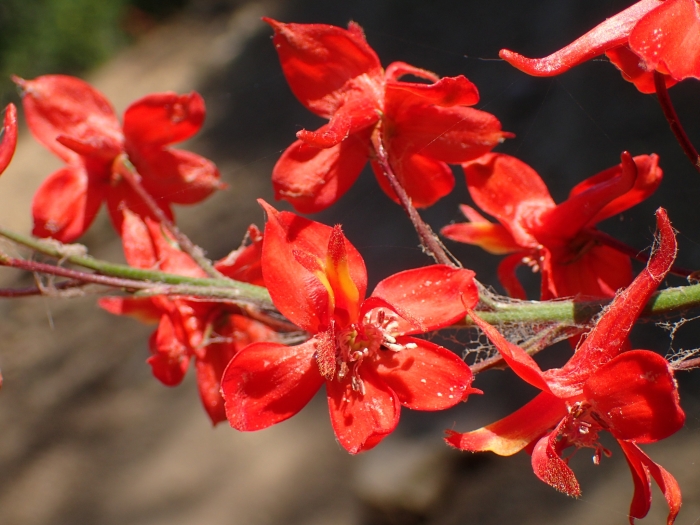Scarlet Larkspur
(Delphinium cardinale)
Scarlet Larkspur (Delphinium cardinale)
/
/

George Williams
CC BY 4.0
Image By:
George Williams
Recorded By:
Copyright:
CC BY 4.0
Copyright Notice:
Photo by: George Williams | License Type: CC BY 4.0 | License URL: http://creativecommons.org/licenses/by/4.0/ | Rights Holder: George Williams | Publisher: iNaturalist | Date Created: 2020-06-25T09:11:06-07:00 |




















































Estimated Native Range
Summary
Delphinium cardinale, commonly known as Scarlet Larkspur, is a deciduous perennial herb native to the chaparral and coastal sage scrub of California, as well as the forested areas of Baja California in Northern Mexico. It can reach a height of over 6 feet with an erect stem and is characterized by its deeply lobed leaves. The inflorescence is a raceme of striking scarlet red flowers, each with sepals that curl forward to form a bowl shape and petals that are scarlet with bright yellow blotches. The flowers, which can be up to 3 centimeters wide and long including the spur, are particularly showy and are designed to attract hummingbirds, which are their primary pollinators. Flowering occurs from late spring to early summer.
Scarlet Larkspur is valued for its vibrant flowers and ability to attract wildlife, making it a desirable addition to native plant gardens, borders, and wildlife-friendly landscapes. It requires part shade and can tolerate low to medium water conditions, making it suitable for xeriscaping. While it prefers well-drained soils, it is adaptable to various soil types. Gardeners should note that all parts of the plant are highly toxic if ingested. It is also susceptible to powdery mildew and rust, which can be mitigated by ensuring good air circulation around the plants.CC BY-SA 4.0
Scarlet Larkspur is valued for its vibrant flowers and ability to attract wildlife, making it a desirable addition to native plant gardens, borders, and wildlife-friendly landscapes. It requires part shade and can tolerate low to medium water conditions, making it suitable for xeriscaping. While it prefers well-drained soils, it is adaptable to various soil types. Gardeners should note that all parts of the plant are highly toxic if ingested. It is also susceptible to powdery mildew and rust, which can be mitigated by ensuring good air circulation around the plants.CC BY-SA 4.0
Plant Description
- Plant Type: Herb
- Height: 4-6 feet
- Width: 0.667-1 feet
- Growth Rate: Moderate
- Flower Color: Red
- Flowering Season: Spring, Summer
- Leaf Retention: Deciduous
Growth Requirements
- Sun: Part Shade
- Water: Low, Medium
- Drainage: Medium
Common Uses
Bee Garden, Bird Garden, Butterfly Garden, Deer Resistant, Hummingbird Garden, Rabbit Resistant, Showy Flowers
Natural Habitat
Chaparral, coastal sage scrub, and forested areas of California and Northern Mexico
Other Names
Common Names: Cardinal Larkspur, Kardinalriddarsporre
Scientific Names: , Delphinium cardinale, Delphinium cardinale var. angustifolium, Delphinium flammeum, Delphinium coccineum,
GBIF Accepted Name: Delphinium cardinale Hook.